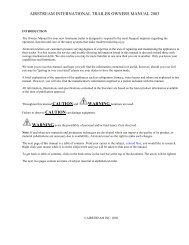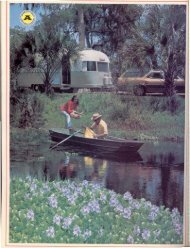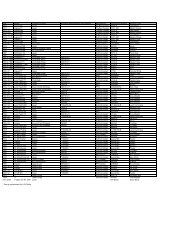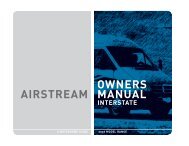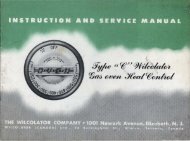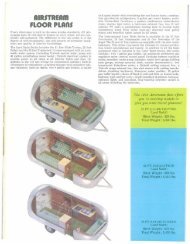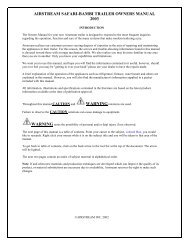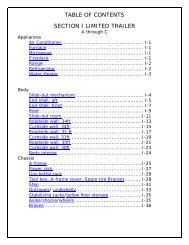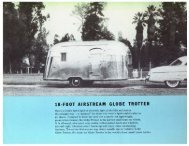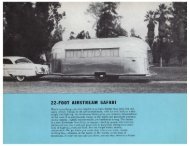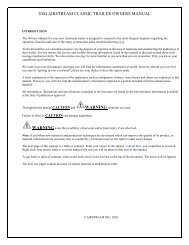Classic - Airstream
Classic - Airstream
Classic - Airstream
Create successful ePaper yourself
Turn your PDF publications into a flip-book with our unique Google optimized e-Paper software.
TIRES<br />
Load/Inflation Information for Your Tires<br />
Maintaining proper tire inflation pressure is essential for both tire safety and<br />
performance.<br />
Proper Tire Inflation<br />
The level of air in your tires affects your vehicle’s overall performance. Not<br />
even the highest quality tire will perform well if it’s not inflated properly. The<br />
correct pressure varies from vehicle to vehicle and depends in part upon driver<br />
preference. Each vehicle has a maximum inflation pressure, usually found<br />
on a metal tag riveted to the outside of the vehicle as well as on the original<br />
equipment tires.<br />
Correct tire inflation is a key component in tire care. The recommended inflation<br />
pressures for your tires are indicated on the certification label or in your owner’s<br />
manual. Since RVs can be loaded with many different configurations, the load<br />
on each tire will vary. For this reason, air pressure should be checked based<br />
on the load on each individual tire. Cold Inflation Pressure should be adjusted<br />
to handle the maximum tire load, and all tires on the axle should carry the<br />
same inflation pressure. COLD TIRE INFLATION PRESSURE is the tire pressure<br />
checked in the morning before you drive more than a few miles or before rising<br />
Exterior<br />
ambient temperatures or the sun’s radiant heat affects it. Check your tires’ air<br />
pressures at least once a month, before each trip and each morning you drive<br />
during a trip. Tire pressure should be checked cold, as tire pressure ratings<br />
have been designed with typical running heat/pressure build-up in mind. Make<br />
sure the valves and caps are free of dirt and moisture.<br />
Under Inflation<br />
Under inflation brings a higher risk of damage due to road hazards, reduces<br />
casing durability, causes a loss in fuel economy, and uneven or irregular tire<br />
wear. Severe under inflation brings about an increased risk of tread separation,<br />
handling difficulties, and possibly tires failure, caused by overheating.<br />
IMPORTANT: Lowering tire pressure in the search for a smoother ride is not<br />
only dangerous, it’s relatively ineffective, and as the difference in the ride<br />
quality is not significant. When minimum inflation pressure requirements are<br />
not met, tire durability and optimum operating conditions are compromised.<br />
Tire inflation pressure should always meet the guidelines for vehicle<br />
weight.<br />
• It may be necessary to inflate your tires at a truck stop or truck service<br />
center in order to achieve adequate air pressure for your coach’s needs<br />
• Only permanent air seal metal valve caps should be used.<br />
• Be safe - if a tire has been run 20% under inflated, it must be dismounted<br />
and inspected by a trained professional. It should not be aired up without a<br />
D<br />
D - 9



